Pence Opera House
The Pence Opera House was built by John Wesley Pence, the President of the City Bank of Minneapolis, originally from Ohio. The Opera House was located at 126-128 Hennepin Ave. at Second Street in Minneapolis.
Its original name was planned as the Pence Music Hall. It got grander as things progressed, and on June 19, 1867, Mr. Pence replaced the Music Hall sign with Opera House. The theater was located on the third floor of the building and contained a balcony – an innovation at that time. Its architect was Abraham M. Radcliffe.
The three-story building housed shops on its first floor, offices on its second, a billiard parlor in the basement, and the theater on the third.
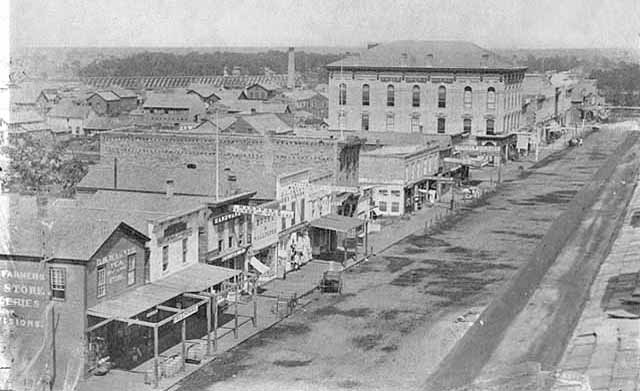
Hennepin Avenue, 1867. Pence in upper right. Photo MHS
The Pence opened on June 21, 1867, with a joint concert of the Minneapolis Musical Union and the St. Paul Musical Society. It had a seating capacity of 700.
Its first dramatic production was Sheridan Knowles’ play, “The Hunchback,” starring Rachel Johnson, on June 24, 1867. The performance was attended by Governor William Marshall and Senator Alexander Ramsey.
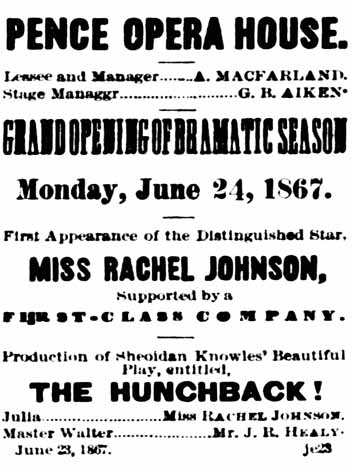
Minneapolis Daily Tribune, Sunday, June 23, 1867
One writer posits that the Pence was overshadowed by the Academy of Music, which was built in 1871 at the corner of Washington and Hennepin Avenues. That building closed in 1883, but was replaced by another, grander Opera House, and so on.
Sometime in 1879, the Metropolitan Theater Company took residence in the Pence Opera House, and the theater itself became known as the Metropolitan Theater. Also in 1879, the theater was remodeled and increased its capacity to 900.
In September 1880 the Criterion Theater stock company replaced the Metropolitan Theater Company, which had some to a “somewhat inglorious end.” The Criterion ended their stay in January 1881.
On January 24, 1881, the Pence Opera House re-opened with a new stock company. It apparently operated until mid-May 1885, with a hiatus until another re-opening in January 1886.
Pence refers to a panic caused by an accident to a trapeze performer and that the theater closed its doors in 1888.
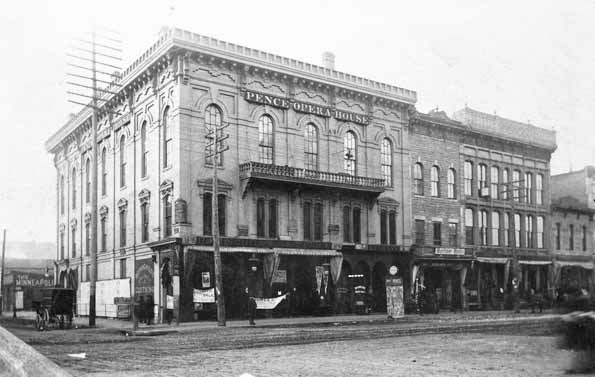
1882 – Minnesota Historical Society
In October 1889, receipts were so poor that the manager dismissed the company for the season. It re-opened on December 17, 1889, to a packed house to see a novelty act. Further performances appeared to be sporatic.
In June 1890 the theater was leased by Edward Hilton, who began renovations for the fall season. The Pence opened as a burlesque and vaudeville house in the fall of 1890. By January 1891 Hilton was discouraged, and talking to Pence, who still owned the building, about erecting a more modern structure that faced Hennepin Avenue and was on the first floor. Vaudeville performances struggled on until about May 1892. In April 1894 it had become an Oriental Museum – only men had to pay the admission of 10 cents.
The last performance was a benefit given for the manager, Edward P. Hilton, on June 12, 1894.
The 1894 season was to begin on October 1 with a vaudeville company on board, but the performance and the season never happened. Pence died in late May 1893 and he was buried at Lakewood Cemetery. Having no will, his fortune of approximately $1 million was divided between three brothers and two sisters, none of whom lived in Minnesota. The paper reported that his estate was contemplating tearing down the building. The doors were locked and the theater went dark.
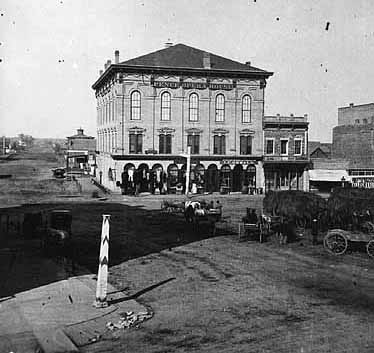
Pence 1896. Photo Minnesota Historical Society
THE FLOUR CITY CLUB
On June 4, 1901, police raided the “Twin City Club and Employment Bureau” on the second floor of the old Pence building. This club was made up of black men and women, some of whom lived there permanently. The entire detective detail hauled away 25 men, gambling paraphernalia, and Henry Mosely, the “proprietory,” who was fined $100 for selling liquor without a license. Seventeen men paid fines, three went to the workhouse, and the City netted $260.
In July 1905 another gambling arrest tells us that Edward Stewart was the proprietor.
In April 1911 the cops raided the club again – now called the Flour City Club – for gambling. Ed Stewart was still the proprietor.
Finally in November 1911, police conducted the last raid, arresting Stewart for keeping a gambling house, and 30 others for being found in a disorderly house. Stewart complained that he was being discriminated against because of a “sudden spasm of righteousness. It was well known that I run a small crap game there, and I was told there would be nothing said about it. Only colored people patronized my club and they must have a place of amusement.” Stewart was right, in that the police were cracking down in an attempt to find out if there was public bribery going on.
In 1906 the City proposed the site for a new Post Office but it was not chosen.
An article from March 15, 1908, gives the status of the old theater in flowery language:
For 16 years it has been dark – a dumping place for rubbish. Years ago its footlights faded out altogether. The violins in the pit trembled over the last finale. Actors and audience passed down the old humanity market staircase, and its proud history passed into the bygone.
UNION CITY MISSION
In 1912 the Union City Mission began to raise funds to buy the Pence building, with the intention of erecting a seven-story social services building and “workingman’s hotel.” The planners hoped to house 400-500 men in 185 rooms. The building was purchased by the Mission in 1913.
In 1915 it was determined that the old building would have to do until a new one could be built. The War in Europe was making it difficult to build. Plans had now grown to a 12-story building. The old one was was given a new coat of yellow paint, a new roof, new plumbing, facade, and the gallery railing was to be made into part of the Altar. The Tribune (April 18, 1915) described the mess that had been made of the old theater, and how small it had been compared to contemporary venues.
In 1923 the building was given a new facade and the auditorium enlarged.
On January 27, 1935, the Minneapolis Tribune described the inside of the theater:
Around the dome were pictured eight angel children dancing, with figures of the four seasons nearby. Beside the stage on either side, were Washington holding a sword in one hand and the Constitution in the other, and Lincoln with a scroll. Over the gallery in the rear was a portrait of President Andrew Jackson, while over the stage was seen a bust of Shakespeare, surrounded by a wreath of leaves supported by two female figures with angel appendages, one on each side. Over the boxes were Tragedy and Comedy, and above the arch was the American eagle, standing on a shield, while from his mouth flowed a streamer with the words, J.W. Pence, dedicated June, 1867.
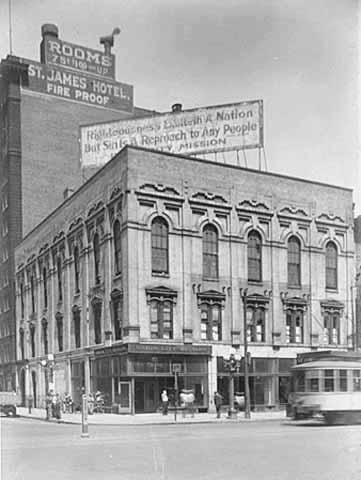
Union City Mission, 1936. Photo MHS
In the April 8, 1952, Minneapolis Star, photos were shown of the inside of the building as the Union Mission prepared it for renovations. A new Mission, incorporating parts of the theater and taking the place of some demolished buildings, was dedicated in November 1953.
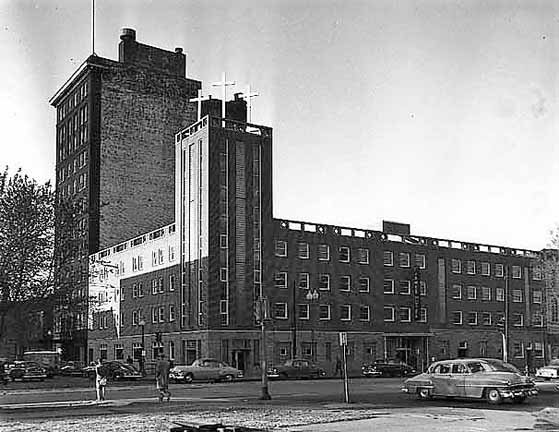
Union City Mission, November 7, 1953. Photo MHS
The Union City Mission was one of the many buildings demolished during the clearance of the Gateway. It was demolished in late August 1963.
Also see: Playhouse for Pioneers: The Story of the Pence Opera House by Donald Z. Woods
